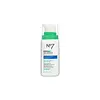What's inside
What's inside
 Key Ingredients
Key Ingredients

 Benefits
Benefits

 Concerns
Concerns

 Ingredients Side-by-side
Ingredients Side-by-side

Water
Skin ConditioningParaffinum Liquidum
EmollientPPG-15 Stearyl Ether
EmollientCetearyl Alcohol
EmollientButylene Glycol
HumectantParaffin
PerfumingGlyceryl Stearate
EmollientGlycerin
HumectantDimethicone
EmollientPEG-20 Stearate
EmulsifyingOenothera Biennis Oil
EmollientTocopheryl Acetate
AntioxidantCera Microcristallina
Emulsion StabilisingXanthan Gum
EmulsifyingPropylene Glycol
HumectantMethylparaben
PreservativePropylparaben
PreservativeSodium Lactate
BufferingTetrasodium EDTA
Sambucus Nigra Flower Extract
RefreshingLactic Acid
Buffering2-Bromo-2-Nitropropane-1,3-Diol
PreservativeBHT
AntioxidantSorbitol
HumectantCI 14700
Cosmetic ColorantCI 42090
Cosmetic ColorantWater, Paraffinum Liquidum, PPG-15 Stearyl Ether, Cetearyl Alcohol, Butylene Glycol, Paraffin, Glyceryl Stearate, Glycerin, Dimethicone, PEG-20 Stearate, Oenothera Biennis Oil, Tocopheryl Acetate, Cera Microcristallina, Xanthan Gum, Propylene Glycol, Methylparaben, Propylparaben, Sodium Lactate, Tetrasodium EDTA, Sambucus Nigra Flower Extract, Lactic Acid, 2-Bromo-2-Nitropropane-1,3-Diol, BHT, Sorbitol, CI 14700, CI 42090
Water
Skin ConditioningDicaprylyl Carbonate
EmollientGlycerin
HumectantAnnona Cherimola Fruit Extract
Skin ConditioningSaccharide Isomerate
HumectantNiacinamide
SmoothingPropanediol
SolventPanthenol
Skin ConditioningSodium Polyacrylate
AbsorbentTrifolium Pratense Flower Extract
AstringentAcrylates/C10-30 Alkyl Acrylate Crosspolymer
Emulsion StabilisingPhenoxyethanol
PreservativeButylene Glycol
HumectantPolysorbate 20
EmulsifyingSodium Hyaluronate
HumectantCaprylyl Glycol
EmollientSodium Benzoate
MaskingSodium Lauroyl Lactylate
EmulsifyingBisabolol
MaskingSodium Citrate
BufferingEthylhexylglycerin
Skin ConditioningTetrasodium EDTA
Panax Ginseng Root Extract
EmollientCitric Acid
BufferingLecithin
EmollientCeramide NP
Skin ConditioningBiphenyl Azepanyl Methanone
Skin ConditioningPhenylpropanol
MaskingSodium Dehydroacetate
PreservativeCeramide AP
Skin ConditioningPhytosphingosine
Skin ConditioningCholesterol
EmollientCarbomer
Emulsion StabilisingXanthan Gum
EmulsifyingTocopherol
AntioxidantBiotin
AntiseborrhoeicCeramide EOP
Skin ConditioningWater, Dicaprylyl Carbonate, Glycerin, Annona Cherimola Fruit Extract, Saccharide Isomerate, Niacinamide, Propanediol, Panthenol, Sodium Polyacrylate, Trifolium Pratense Flower Extract, Acrylates/C10-30 Alkyl Acrylate Crosspolymer, Phenoxyethanol, Butylene Glycol, Polysorbate 20, Sodium Hyaluronate, Caprylyl Glycol, Sodium Benzoate, Sodium Lauroyl Lactylate, Bisabolol, Sodium Citrate, Ethylhexylglycerin, Tetrasodium EDTA, Panax Ginseng Root Extract, Citric Acid, Lecithin, Ceramide NP, Biphenyl Azepanyl Methanone, Phenylpropanol, Sodium Dehydroacetate, Ceramide AP, Phytosphingosine, Cholesterol, Carbomer, Xanthan Gum, Tocopherol, Biotin, Ceramide EOP
 Reviews
Reviews

Ingredients Explained
These ingredients are found in both products.
Ingredients higher up in an ingredient list are typically present in a larger amount.
Butylene Glycol (or BG) is used within cosmetic products for a few different reasons:
Overall, Butylene Glycol is a safe and well-rounded ingredient that works well with other ingredients.
Though this ingredient works well with most skin types, some people with sensitive skin may experience a reaction such as allergic rashes, closed comedones, or itchiness.
Learn more about Butylene GlycolGlycerin is already naturally found in your skin. It helps moisturize and protect your skin.
A study from 2016 found glycerin to be more effective as a humectant than AHAs and hyaluronic acid.
As a humectant, it helps the skin stay hydrated by pulling moisture to your skin. The low molecular weight of glycerin allows it to pull moisture into the deeper layers of your skin.
Hydrated skin improves your skin barrier; Your skin barrier helps protect against irritants and bacteria.
Glycerin has also been found to have antimicrobial and antiviral properties. Due to these properties, glycerin is often used in wound and burn treatments.
In cosmetics, glycerin is usually derived from plants such as soybean or palm. However, it can also be sourced from animals, such as tallow or animal fat.
This ingredient is organic, colorless, odorless, and non-toxic.
Glycerin is the name for this ingredient in American English. British English uses Glycerol/Glycerine.
Learn more about GlycerinTetrasodium EDTA is the salt formed from neutralizing ethylenediamine tetraacetic acid with sodium hydroxide. It is a chelating agent and used to prevent metal ions from binding to other ingredients. This helps keep the product and ingredients stable.
Tetrasodium EDTA comes as a white solid and is soluble in water.
Water. It's the most common cosmetic ingredient of all. You'll usually see it at the top of ingredient lists, meaning that it makes up the largest part of the product.
So why is it so popular? Water most often acts as a solvent - this means that it helps dissolve other ingredients into the formulation.
You'll also recognize water as that liquid we all need to stay alive. If you see this, drink a glass of water. Stay hydrated!
Learn more about WaterXanthan gum is used as a stabilizer and thickener within cosmetic products. It helps give products a sticky, thick feeling - preventing them from being too runny.
On the technical side of things, xanthan gum is a polysaccharide - a combination consisting of multiple sugar molecules bonded together.
Xanthan gum is a pretty common and great ingredient. It is a natural, non-toxic, non-irritating ingredient that is also commonly used in food products.
Learn more about Xanthan Gum